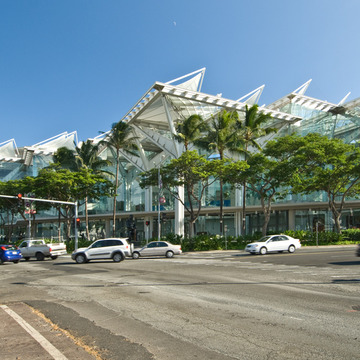Offering state-of-the-art convention facilities within a Hawaiian setting, the four-story convention center dominates the Kalakaua Avenue gateway to Waikiki. Sited on ten acres, it features more than six acres of outdoor space that includes roof gardens, elevated promenades, and courtyards. The center is an assertive and distinctive design with teflon-coated, fiberglass roof canopies, reminiscent of the sails of voyaging canoes. Featuring floor-to-ceiling windows, the center's 35,000-square-foot lobby includes abstracted palm columns of steel supporting the transparent ceiling, forty-foot-tall live coconut palms, and a seventy-foot waterfall. The lobby houses the longest escalator in Hawaii, providing a scenic journey to the third floor.
The building offers some of the largest enclosed spaces in Hawaii. The 200,000-square-foot ground-level exhibit hall with its 35-foot-high ceiling can accommodate three football fields, but may be divided into three smaller spaces. The third floor contains meeting rooms and two presentation theaters, and the 2.5-acre roof garden includes a 35,990-square-foot ballroom sheltered under a double-pitched hipped roof. A lily pond with Satoru Abe's sculpture Reaching for the Sun and a winding stream soften the roof garden's hardscape. A grand staircase with an accompanying waterfall cascades from terrace to terrace, terminating on the Ala Wai promenade with its rows of Chinese banyans.
The center's decorative program features kapa-inspired, chevron-motif masonry screens and light fixtures depicting silhouetted hala, papaya, and heliconia. Two landscaped courtyards on the third floor serve as further reminders of Hawaii. Artworks also celebrate the Islands, including large murals on the third floor by such artists as Jean Char-lot, Masami Teraoka, Jay Wilson, Matauma Alisa, Hans Ladislaus, and David Kuraoka. The drinking fountains are enlivened by artworks from Doug Young, Bob Flint, Don Dugal, and Carol Bennett.


